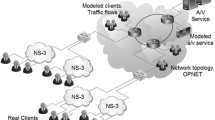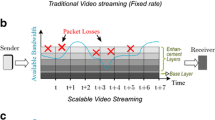Abstract
The availability of high-performance networking technologies and processing power allows creation of new multimedia services and applications in broadband integrated services networks. Such new services will be successful only if delivered to end-users at low cost. At present, for wide-area distributed systems, communication has a relevant impact on the overall costs. As a consequence, adequate methodologies for an efficient dimensioning of the network resources need to be devised. Simulation techniques represent a powerful instrument for the analysis and evaluation of real systems. This paper, moving from the definition of mathematical models for VBR video sources, presents the application of a simulation approach to verify the compatibility of the communication load related to a set of video streams with the data transport capability of an existing network architecture for the delivery of video streams, in the case of CBR communication links.
Similar content being viewed by others
References
R. Canonico, S.P. Romano and G. Ventre, Admission control policies in integrated services networks, Dipartimento di Informatica e Sistemistica, Universitá di Napoli Federico II, Italy (1998).
P. Crocetti and L. Fratta, Video on demand service based on ATM virtual private networks, in: Proceedings of ECMAST '96, Louvain-la-Neuve, Belgium (1996).
L. D'Ardia, Analisi e simulazione di sorgenti di traffico video digitale, Tesi di Laurea, Dipartimento di Informatica e Sistemistica, Universitá di Napoli Federico II, Italy (1997).
L. D'Ardia, B. Fadini and G. Ventre, Analysis, classification and simulation of multimedia traffic sources, in: Proceedings of DCCN '97, Distributed Computer Communication Networks, Tel Aviv (1997).
R. Garg, Characterization of video traffic, Technical Report, TR–95–007, International Computer Science Institute, Berkeley, CA (1995).
D.P. Heyman and T.V. Lakshman, Source models for VBR brodcast-video traffic, IEEE/ACM Transactions on Networking 4(1) (1996) 40–48.
M. Krunz and S.K. Tripathi, Modeling bit rate variations in MPEG sources, Technical Report CS-TR-3573, Department of Computer Science, University of Maryland at College Park (1996). Available at http://www.cs.umd.edu/TRs/ authors/Satish K Tripathi.html.
A.A. Lazar, G. Pacifici and D.E. Pendarakis, Modeling video sources for real-time scheduling, ACM/Springer, Multimedia Systems 1(5) (1994) 253–266.
D. LeGall, MPEG: a video compression standard for multimedia applications, Communications of the ACM 34(4) (1991) 46–58.
B. Maglaris, Performance models of statistical multiplexer in packet video communications, IEEE Trans. on Communications (June 1988) 834–844.
P. Pancha and M. El Zarki, Leaky bucket access control for VBR MPEG video control, in: Proceedings of IEEE Infocom '95, Boston, MA (1995).
O. Rose, Statistical properties of MPEG video traffic and their impact on traffic modeling in ATM systems, in: Proceedings of the 20th Annual Conference on Local Computer Networks, Minneapolis, MN (1995) pp. 397–406.
Author information
Authors and Affiliations
Rights and permissions
About this article
Cite this article
Canonico, R., D'Ardia, L. & Ventre, G. A simulation based approach for network resources dimensioning in video delivery systems. Telecommunication Systems 11, 187–199 (1999). https://doi.org/10.1023/A:1019145217722
Issue Date:
DOI: https://doi.org/10.1023/A:1019145217722




